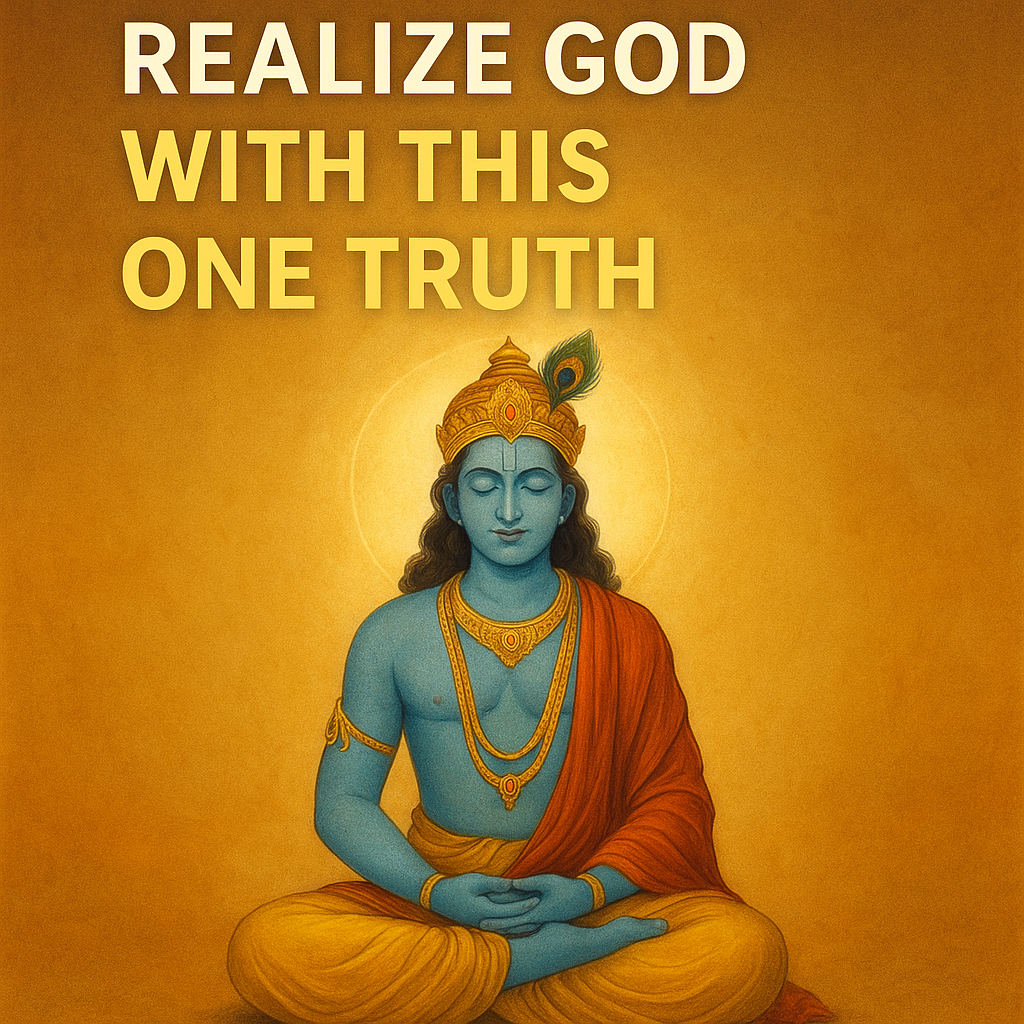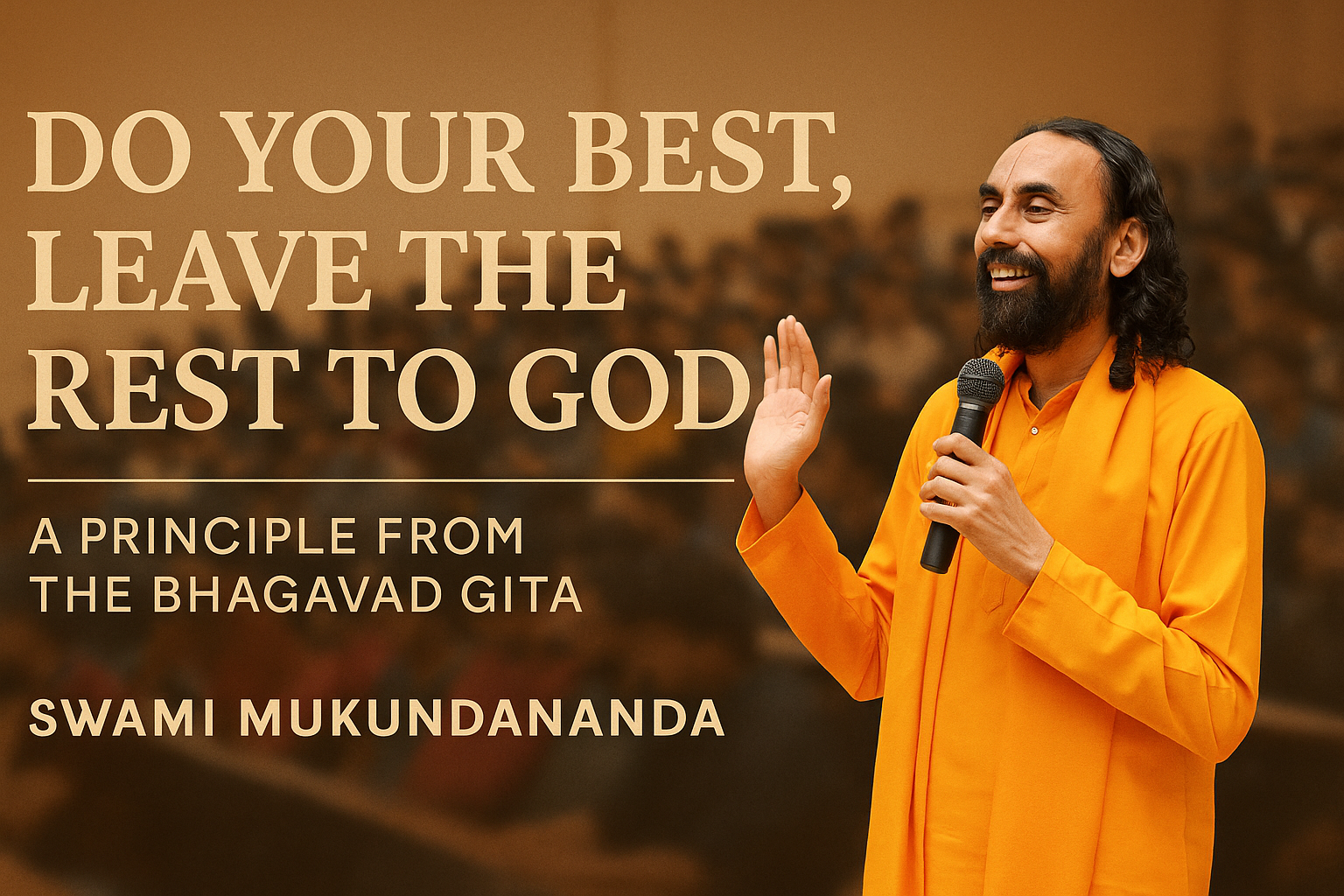The Soul, God, and Maya
Swami Mukundananda explains how the soul, God, and Maya exist in the same space. Maya creates the world, and we souls live within it. God pervades both Maya and the soul. What separates us from God is not distance, but our lack of faith and awareness.
The Illusion of Separation
The reason we feel disconnected is because of our inverted consciousness—our mind is turned away from God. The solution is to turn inward, to reestablish connection. This reconnection is the essence of true yoga.
True Yoga According to Saints
Jagadguru Shri Kripalu Ji Maharaj says:
“True yoga is that which connects the soul with God.”
All practices that do not lead to this connection are kuyog (false yoga), even if they look spiritual externally.
The Divine Love of the Gopis for Lord Krishna: A Story Beyond Logic
In the sacred land of Vrindavan, there lived simple village women known as the Gopis. Externally, they appeared to be just ordinary cowherd women — engaged in daily chores, tending cattle, and taking care of their households. But their hearts held something extraordinary — a boundless, divine love for Lord Krishna.
From a very young age, Krishna, the darling child of Nanda and Yashoda, captivated the hearts of the Gopis. His divine playfulness, his enchanting flute, and his radiant beauty left an indelible impression on their souls. It was not merely an attraction; it was pure, unconditional devotion — the highest form of Bhakti.
Swamiji narrates a beautiful incident to illustrate the depth of this devotion.
The Gopis, eager to see Krishna, would often make excuses to visit his home. One Gopi would carry a pot of yogurt and call out, “Lo dahi! Lo dahi!” (“Take yogurt! Take yogurt!”). But was she truly interested in selling yogurt? Not really. Her true desire was to catch a glimpse of Nandalal — the son of Nanda — who lived there.
Even though Nanda Baba’s home had plenty of cows and abundant yogurt, the Gopi still came, pretending to sell what the house already had, just for the chance to see Krishna.
Swamiji emphasizes that this was no ordinary affection. Their actions may have appeared irrational to the outside world — abandoning their homes, duties, and social norms — but this love was rooted in a spiritual truth. It transcended logic, society, age, and even dharma in the worldly sense. It was a state of madness for God, but in the highest, most exalted form.
When Sage Shukadev narrated this story to King Parikshit during the discourse of the Shrimad Bhagavatam, Parikshit was puzzled. He asked:
“Every mother loves her own child. Why would the Gopis be so eager to see Yashoda’s son? Why such longing for someone else’s child?”
Shukadev Ji responded with profound spiritual insight:
“O King, Krishna is not just the son of Yashoda. He is the soul of all souls — the Atma of every being. Your soul is a part of God, and God is the soul of your soul. The Gopis were not merely attracted to Krishna’s form as Yashoda’s child; they were pulled by the innate longing of the soul for the Supreme Soul.”
This story serves as a spiritual metaphor. Just like the Gopis, our soul deeply longs for union with the Divine, but we are often distracted by the illusion of the material world (Maya). The Gopis had crossed that veil. Their minds, hearts, and souls were absorbed in Krishna alone.
Swamiji explains that true Yoga (union) is not about physical postures or even intellectual knowledge. It is about Bhakti — heartfelt, loving remembrance of God. The Gopis exemplified this true yoga through their lives.
Their love did not require rituals, qualifications, or elaborate ceremonies. It was simple, direct, and overwhelming — the kind of love where one forgets the self and remembers only God.
This story teaches us that divine love transcends all logic, social boundaries, and worldly responsibilities. It is the most natural expression of the soul — a call to return to its eternal source.
Spiritual Insights from the Upanishads
The Story of Sage Bhrigu – Realizing God Through Experience (From the Taittiriya Upanishad)
In the ancient scriptures of India, particularly the Taittiriya Upanishad, there is a powerful story that reveals a deep spiritual truth — that everything originates from, exists in, and eventually returns to God.
This story is about Sage Bhrigu, the son of Varuna, who was not just a great sage but also a seeker of the highest truth — the knowledge of Brahman, the ultimate reality.
One day, Bhrigu approached his father Varuna, who was also a realized soul, and said:
“O revered father, please teach me Brahman, that Supreme Divine entity from whom everything is born, by whom all beings live, and into whom they merge after death.”
Varuna did not give him a direct answer. Instead, he instructed his son with a profound teaching:
“Yato vā imāni bhūtāni jāyante
Yena jātāni jīvanti
Yat prayanty abhi samviśanti
Tad vijijñāsasva tad brahma.”
“Understand That from which all beings are born,
That by which they live,
That into which they merge —
That alone is Brahman.”
With these words, Varuna encouraged Bhrigu to meditate and realize the truth through inner inquiry, rather than mere intellectual knowledge.
Bhrigu’s Journey of Realization
Following his father’s instruction, Sage Bhrigu began to meditate.
- First, he contemplated that food (Annam) is Brahman – because all living beings are born of food, live by food, and ultimately merge into food (earth).
But he felt this couldn’t be the ultimate truth. There must be something deeper. - Then he thought, Prana (life-force or breath) is Brahman – it is subtler than food and gives life to food itself. But again, he found this to be an incomplete understanding.
- Next, he contemplated that Mind (Manas) is Brahman – because it governs life and breath. Still, he felt it wasn’t the complete reality.
- He then meditated upon Vijnana (intellect or knowledge) as Brahman. But he realized that even intellect is limited and cannot be the source of all.
- Finally, he meditated on Bliss (Ananda) and realized:
“Ananda is Brahman.”
The Supreme Divine is the source of all joy, all love, all peace — it is the ultimate truth that pervades everything.
The Revelation
Through deep meditation, Bhrigu came to understand that:
- God is the origin of all creation.
- God is the sustaining power in every being.
- God is the final resting place of all existence.
In the Upanishadic language, this realization is called “Brahmavidya” — the knowledge of the Absolute.
God as the Holder of All Existence
Swami Mukundananda beautifully explains this idea with a relatable analogy:
Imagine a mobile phone being held by a hand. The phone cannot hold the hand; it is the hand that supports the phone.
Likewise, we are held by God, not the other way around.
He is the “Dhaarak” (holder), and we are “Dhaaryamaan” (that which is held).
This means that we all reside within God. He is not far away in some distant heaven — He is closer than the closest, pervading every atom of existence, including our own souls.
Conclusion: Realizing God Within
The story of Bhrigu teaches us that true knowledge is not just theoretical — it must be experienced. And that experience reveals one profound truth:
“God is not outside of us. We live in Him. He energizes us, sustains us, and awaits our realization of this eternal bond.”
Just like Bhrigu, we too must contemplate, question, and meditate — for only then can we discover that Divine Truth that liberates the soul and fills life with meaning.
Your Soul is the Body of God
God is not far from us. In fact, He is closer than the closest. He is seated in our hearts. Your soul is His temple, and He is energizing you from within.
The Path to Liberation
When we realize this truth and reconnect consciously, we become God-realized. The Divine Abode—called Vaikunth, Golok, or Akshardham—is where we go after liberation, a place beyond Maya, sun, moon, and return.
One Realization Can Transform Your Life
This spiritual wisdom isn’t just theory. It’s meant to lead you to love God, not just know Him. True knowledge brings about devotion, and through devotion, you realize your Divine identity.
Balance Goals & Spirituality: Swami Mukundananda’s Insight


